The artist William Collins (1788-1847) visited Amalfi and neighbouring towns including Ravello in January 1838. At the
time he was staying in Naples with his wife Harriet and their two sons William
Wilkie Collins and Charles Allston Collins - known to the family as Willie aged
14 and Charley aged 9. William's journal is quoted by
his son Wilkie Collins in the biography he wrote of his father Memoirs of
William Collins, R.A. published in 1848. Wilkie also gives other details of the stay in
Italy, which had begun on Monday 19 September 1836 and was to last almost two
years.
These pages quote William's journal for the visit to Amalfi, Scala, and Ravello over
the few days 22-25 January 1838. Each section has links to explanatory material
and new photographs of many of the places he visited and sights he saw. The
account starts in Pompeii on Monday 22 January 1838. The
total journey is around 90 miles and is shown on this map.
[Monday] 22nd [January
1838].—To Pompei. Remarkably fine day; a most gratifying sight, full of the deepest interest to me. The most striking object I beheld was the Amphitheatre: the scenery around it is sublime, especially Vesuvius, whose original and beautiful shape was sacrificed to fulfil an act of Divine justice, in ending such scenes of cruelty and vice as existed in this profligate city ere it was destroyed.* As an instance of what may be termed the grand, wholly without reference to the moral degredation
[sic] of the entertainments prepared for the people in ancient times, one can conceive nothing more striking than the vast assemblies that once congregated in this spot, which is worthy of an assemblage of Christians meeting for purposes of worship—the most glorious of all the scenes this state of existence can be susceptible of.
Wilkie adds in a footnote:
*The shape of Vesuvius is said to have been materially altered for the worse by the eruption which destroyed Pompei.
|
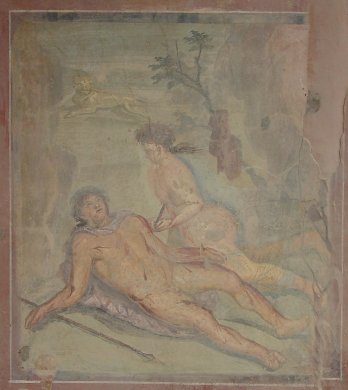
|
|
Pompeii is famed for its voluptuous images |
|
[Tuesday] 23rd [January 1838].—Went with our companions of yesterday, Sir Henry Russell, Lady Russell, and their son
Henry, to
Vietri. Thence, in a boat, to —, and walked to Amalfi. The next day proceeded to the Valley of the Mills, and afterwards to
Ravello, returning by Scala. The whole of this little tour was highly impressive: I never saw such fine scenery before: the Valley of the Mills presents a picture at every step ; the picturesque buildings, and the lofty crags, and old castles in ruins, are most romantic: the road to Ravello full of beauty and grandeur;
|
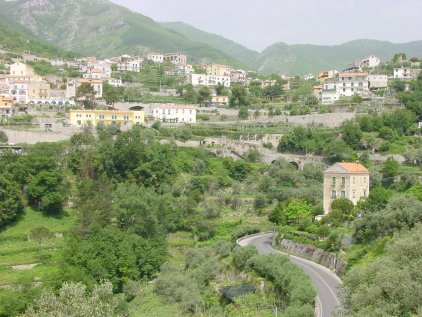 |
|
The road from Ravello to Scala. |
| Ravello itself unlike anything I
ever beheld. Here we saw, in the Duomo, the celebrated marble pulpit, with mosaics as fresh as if they had only been done a few years.
|
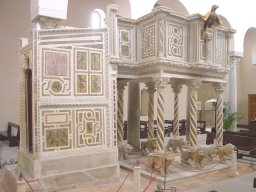
|
|
The 13C pergamo or high pulpit in the Duomo,
Ravello |
| From this we crossed a magnificent valley: the view from the terrace, at the back of a little miserable house where the guides stayed for refreshment, was quite beautiful. Scala itself was full of melancholy grandeur; old Saracenic castles, churches, and other buildings, offering endless food for the painter and the poet. Stopped at the cathedral, where a miserable, dirty old woman showed us a nasty
mitre, worked all over with pearls and precious stones.
|
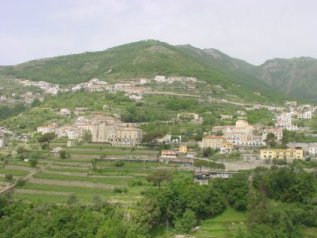
|
|
Scala, and the back of its Duomo, across the valley from
Ravello |
| Descended, by ten times ten thousand steps,
|
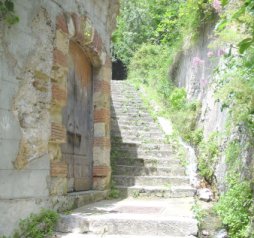
|
|
There are in fact about 2000 steps on the route from
Scala to Amalfi |
| to the cathedral of Amalfi, a rude building, very showy, and in miserable taste, with antique columns of all orders, patching up a temple fit only for those who crowd its neighbourhood— beggars, and dirty, ignorant, vulgar-looking priests. The approach to this building is by about a hundred steps.
|
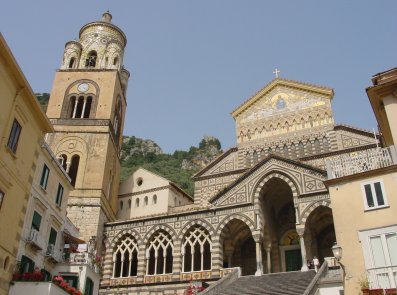
|
|
The front of the Doumo, Amalfi, rebuilt in the late C19 |
| Arrived at Amalfi, you pass through covered filthy ways, up steps to the cliff; and then, by endless steps again, to the inn—a convent twenty-four years ago, but now happily turned to a useful purpose. Dined in a large room, formerly the refectory; and slept in a room about ten feet square, once the dormitory of a monk. The cloisters, the garden, etc., afford many interesting scenes for the pencil. How much I regret not having it in my power to study these, I dare not say. Here, but for my illness in the autumn of last year, I should probably have spent many weeks.
|
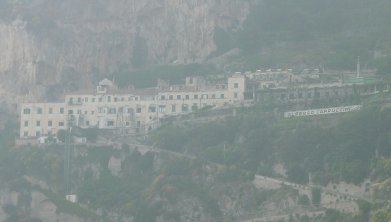
|
|
The Albergo Cappuccino, in the hill above Amalfi |
|
[Thursday] 25th [January 1838].—Returned to Naples by Vietri, La Cava,
Annunciata, etc. The new road from Amalfi to Vietri, along the cliff, about five hours’ ride upon asses, was agreed by all to be most magnificent. Crags and castles, valleys and fishing-towns, goatherds, the most picturesque figures with loads of sticks, and mules and their drivers occasionally enlivening the scene, produced altogether the most enchanting pictures. Here, too, they show you, built in a sort of grotto made by magnificent overhanging crags, the remains of the ‘Casa de S. Andrea.’ A good deal of rain in the early part of our ride; the last half, pretty
fine.
|
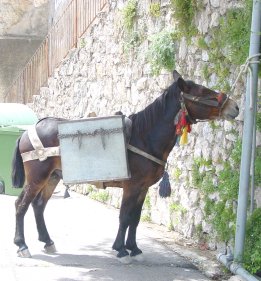
|
|
Mules still used for transport in the hilly towns. |